
Guillaume Herbaut: “For Russia, We, the Photographers, Are the Enemies Too”
Guillaume Herbaut has always explored the places of past tragedies, like Chornobyl, Nagasaki, and Auschwitz. But now he’s documenting a tragedy that unfolds in front of his eyes. After the beginning of the full-scale invasion, he returned to Ukraine and went to visit Bucha, Irpin, Borodianka, Hostomel, the liberated towns in the north of the country, Donbas, Kryvyi Rih, Dnipro, and Odesa. His photo series “From Maydan to Donbas”, which started in 2013, became one of the regional winners of the World Press Photo 2022.

French photographer, documentalist, one of the founders of L’Oleil Public. Explores historical places, filled with memory and symbols, including Chornobyl, Nagasaki, Auschwitz, etc. His works received the World Press Photo award three times, in 2009, 2012, and 2022.
Could you please tell me about your trip to Ukraine this spring? What was your impression?
I was in Ukraine 10 days before the full-scale invasion and then I came back in May. I wanted to come back because I’ve spent so many years here. On one hand, I was glad to be back, but on the other hand, I was devastated because of the war. I’ve been to Bucha, Irpin, Andriivka, and other cities in Ukraine, and it was so excruciating to see what Russians did on Ukrainian land.
After the full-scale invasion started, a lot of photographers stopped taking photos. They thought that photography and art couldn’t change a thing. What about you, do you think photos can make a difference?
I document the war since 2014. Even if I knew that my work wasn’t going to stop it or make a change, I would still report these events in Ukraine. I strive to do more and to do it better to make sure that people don’t forget about Ukraine. I want the audience to see my photos in the media and understand what is happening here.
Without a doubt, the main thing that can make a difference is heavy weapon supply from the West. Whereas my job and the job of other photographers is to document events and convey information.
We are living in a society where one piece of news replaces the other in no time. I’m afraid that one day people will pay less attention to the war and Ukraine will take a back seat. That our society will say that it’s tired of the war and military support to Ukraine will decrease as a result. My job is to help keep the war in focus.
I’m afraid that one day people will pay less attention to the war and Ukraine will take a back seat.

Podilsk (former Kotovsk), December 19, 2013. The Lenin monument was destroyed on the night of December 8-9, 2013
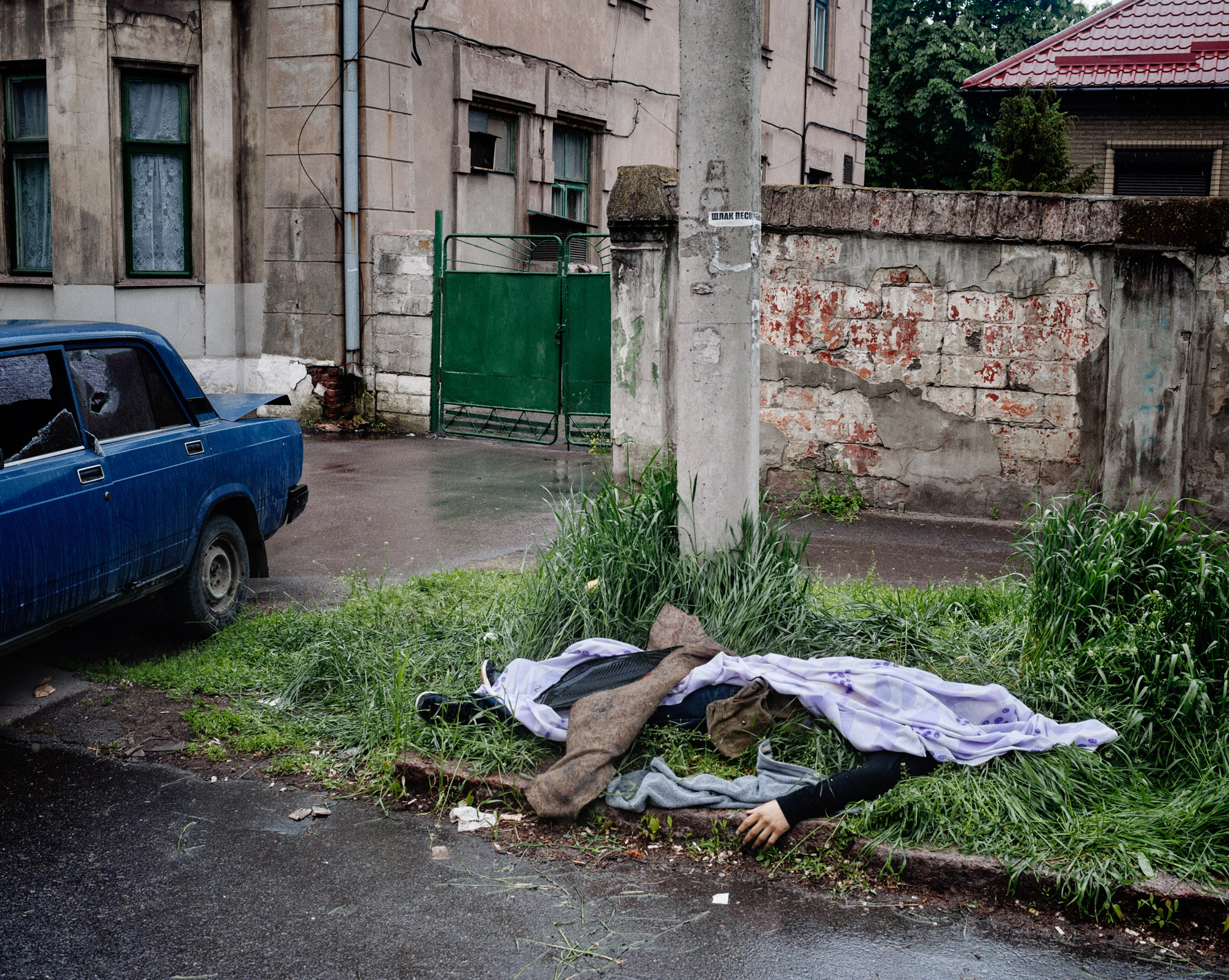
Mariupol, May 9, 2014. A man's body lies in front of a police station after a fight between pro-Russian separatists and the National Guard of Ukraine

Mariupol, September 29, 2014. Women weave snipers’ camouflage in the office of the "New Mariupol" organization, which gathers equipment for the Ukrainian military
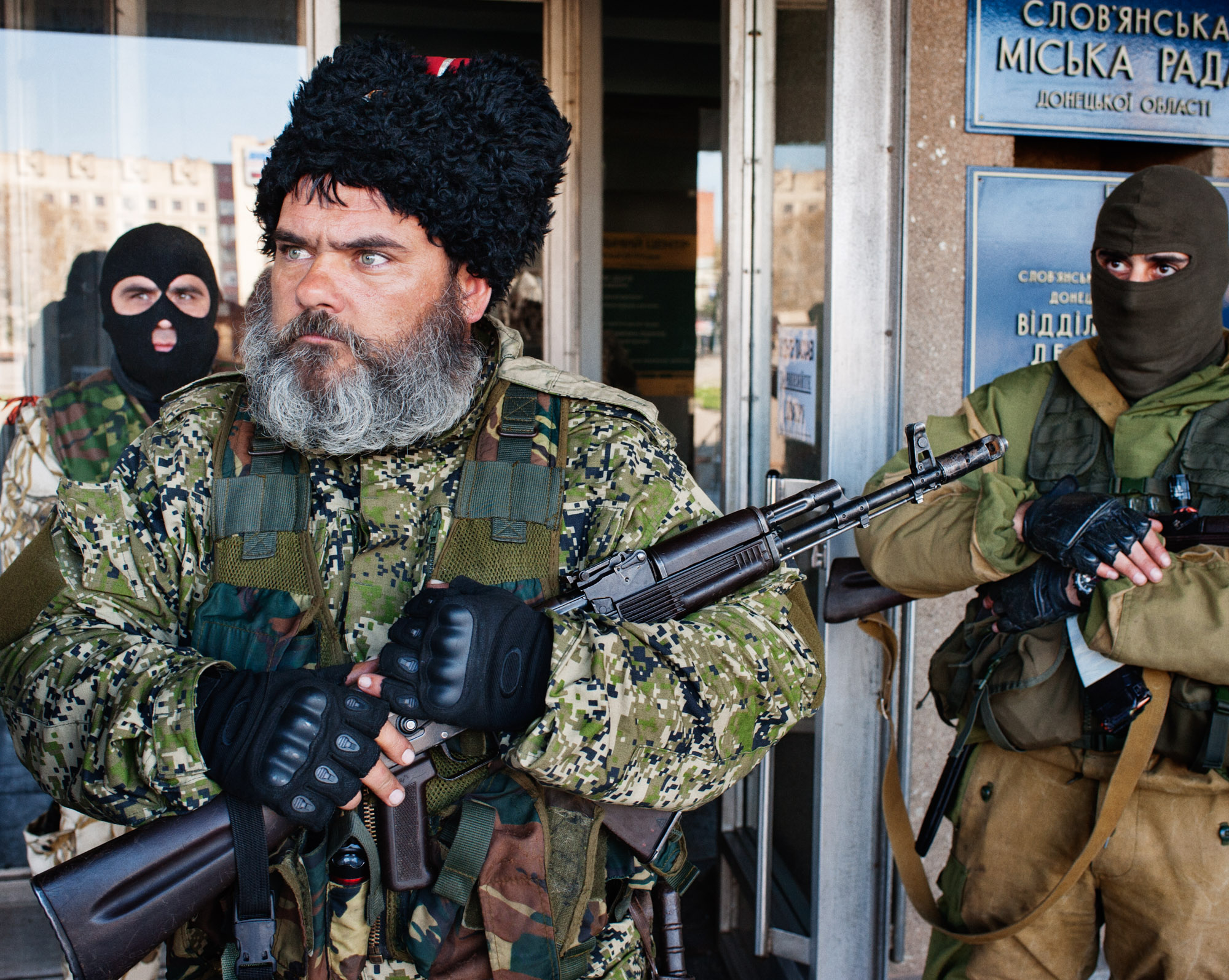
Slovyansk, April 15, 2014. A pro-Russian Cossack guards the entrance to the city council. The building was seized by separatist forces who demanded the independence of Donbass
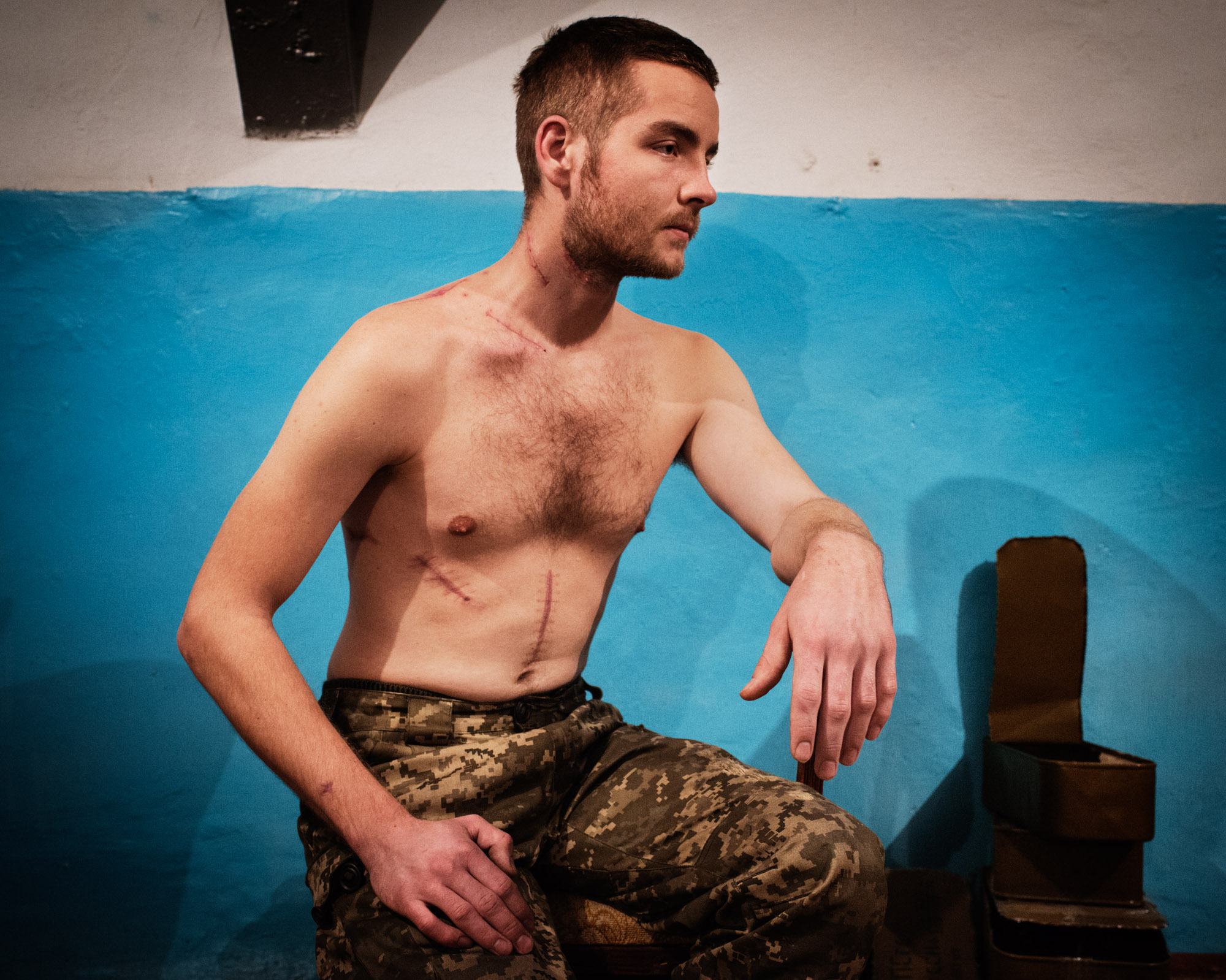
Shchastya, Donbas, December 13, 2014. Dmytro Lavrenchuk, 26, a marketer from Kyiv who joined the Aidar battalion, shows his wounds which he received in an artillery blast during a battle with pro-Russian forces
One military reporter said that the war in Ukraine has no middle ground. One can clearly see who’s the aggressor and who’s the victim. Do you agree with that and do you feel tempted to take the victim’s side as a photographer?
I used to think that one can stay neutral and keep doing their job even in times of war. But on February 24, I realized that in this particular case I had to choose which side I was on. I stand as a pro-Ukrainian photographer in the eyes of the French audience and my French colleagues. I know that I can’t remain neutral in this war.
At the beginning of the full-scale invasion, I organized an exhibition of my works and donated the income to different associations and volunteers who support Ukraine. Recently, I held a presentation of my book and another exhibition, donating the income to Ukrainian photographers to help them continue their work.
In general, do you think documentary photographers should take a certain side or must remain unbiased?
That’s very clear to me. I’m a photographer, but I’m also a citizen. And I take the victim’s side without any second thoughts. You can see who’s the aggressor and who’s the victim in this war. Besides, for Russia, we — photographers and journalists who document the war from the Ukrainian side — are the enemies too.
I’m a photographer, but I’m also a citizen. And I take the victim’s side without any second thoughts.
Has anyone ever claimed that your photos were staged?
No, I’ve never been accused of that. Despite the fact that I have a strong pro-Ukrainian position, I have always tried to remain critical and objective. But I do know that Russians can accuse me of working for Ukrainian propaganda anytime.
That’s what happened to Yevhen Maloletka — Russians said that his photos of Mariupol were staged. They also said that the photos from Bucha were fake. How can a photographer work in the world of post-truth and propaganda, where any image can be accused of being staged?
It doesn’t affect me — it only motivates me to work more and better.
The war in Ukraine is very symbolic, it is the battle between two value systems. On one side we have a country that strives for democracy and independence, and on the other side, there is an obsolete system, which uses authoritarian dictatorship to impose a patriarchal rule. I see it as the war of two civilizations — one is from the twentieth century, and the other is from the twenty-first. Ukraine is a young and ambitious democratic state, and Russia is an old system that belongs to the past.
I saw Yevhen’s (Maloletka. — Editor`s Note) на виставці photos at an exhibition in the French city of Bayeux. What they showed was so terrible that I couldn’t imagine how someone might think that it was staged. That exhibition was a hard experience for me, as it showed the war at its ugliest, like we’d never seen it before.
Yevhen’s photos actually show terrifying things. But propaganda also frequently appeals to emotions, trying to make us feel scared or outraged. How can we tell military documentary photography from propaganda? Do you think the viewers are capable of that?
It’s a difficult question. One should have a culture and experience of perceiving photography. One should understand the complicated processes behind the creation of an image — which angle photographers use, which instruments help create a fake photo, and so on.
Actually, photos do lie sometimes. So it’s important to look at captions, check out the author and find out what’s known about him or her. It’s like when you check the original source of a text. You can do the same with the photos: look for other photos, which were taken in the same place at the same time, or double-check information using Google Images or special software.
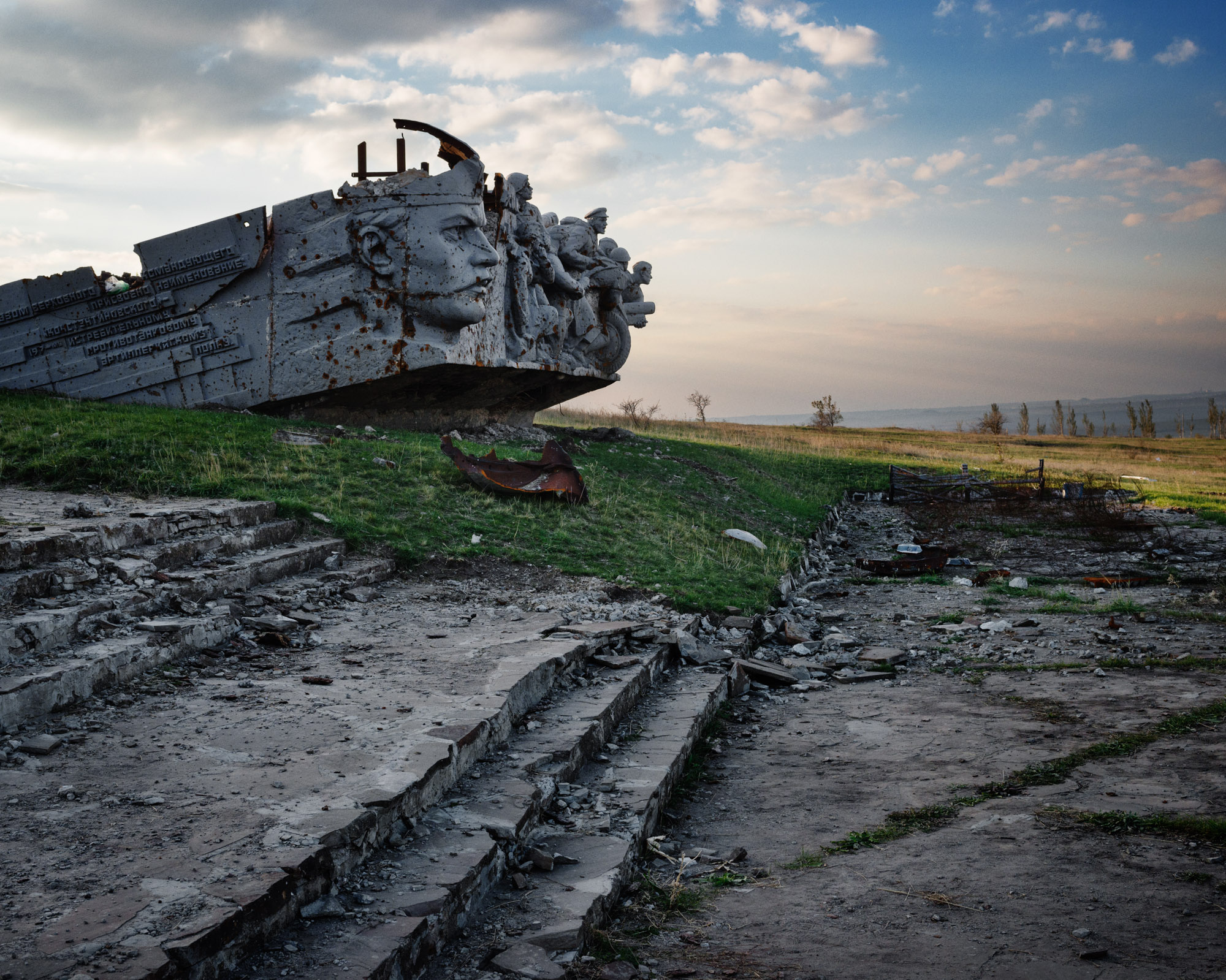
Savur-Mohyla, a memorial honoring fallen soldiers of World War II, 2014. On August 21, 2014, the memorial fell after weeks of heavy shelling during fierce fighting between the Ukrainian army and pro-Russian forces

Pisky, Donbas, November 2017
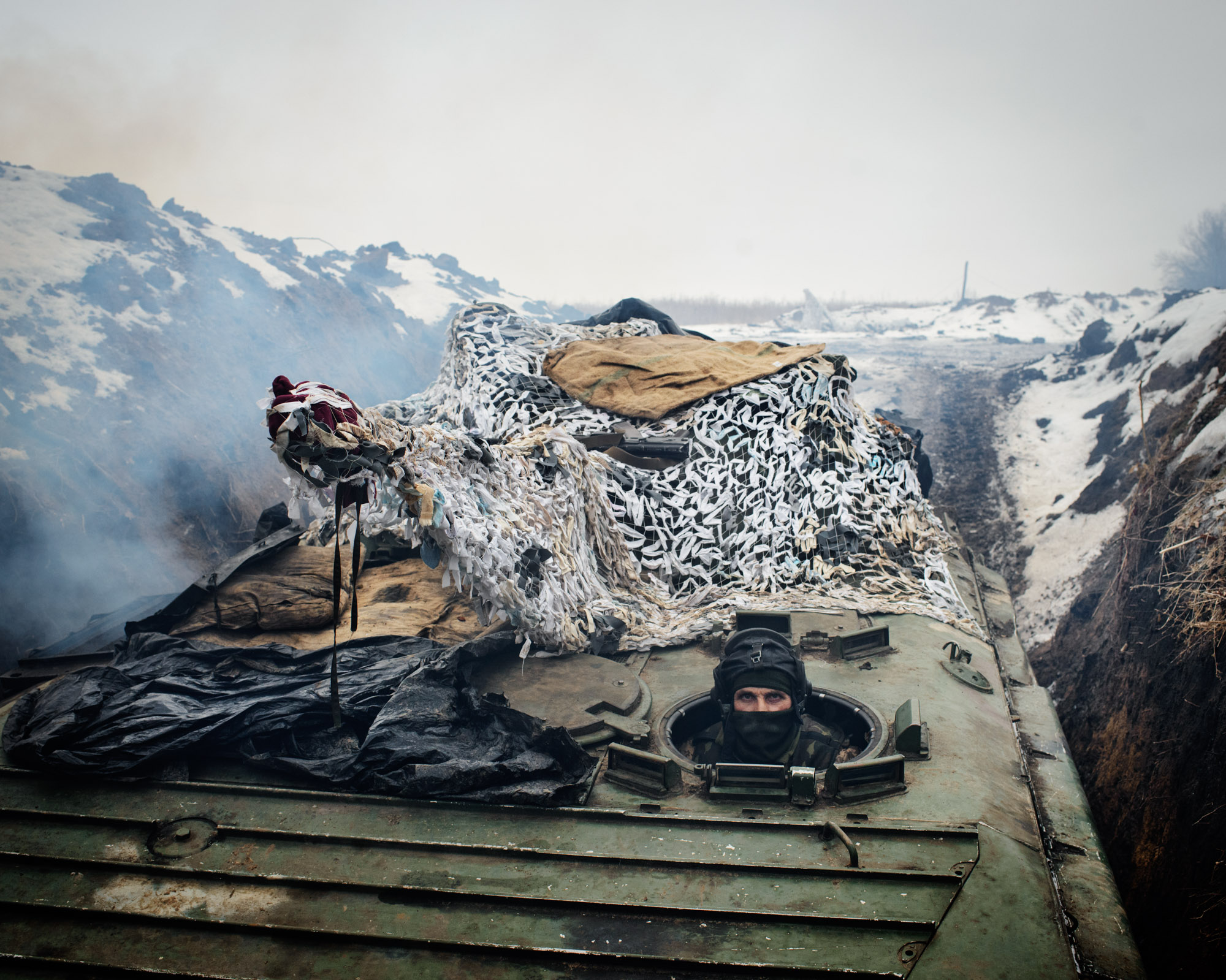
Crimea, 2017. Combat position of the 93rd brigade of the Armed Forces. The first Russian line is a thousand meters away
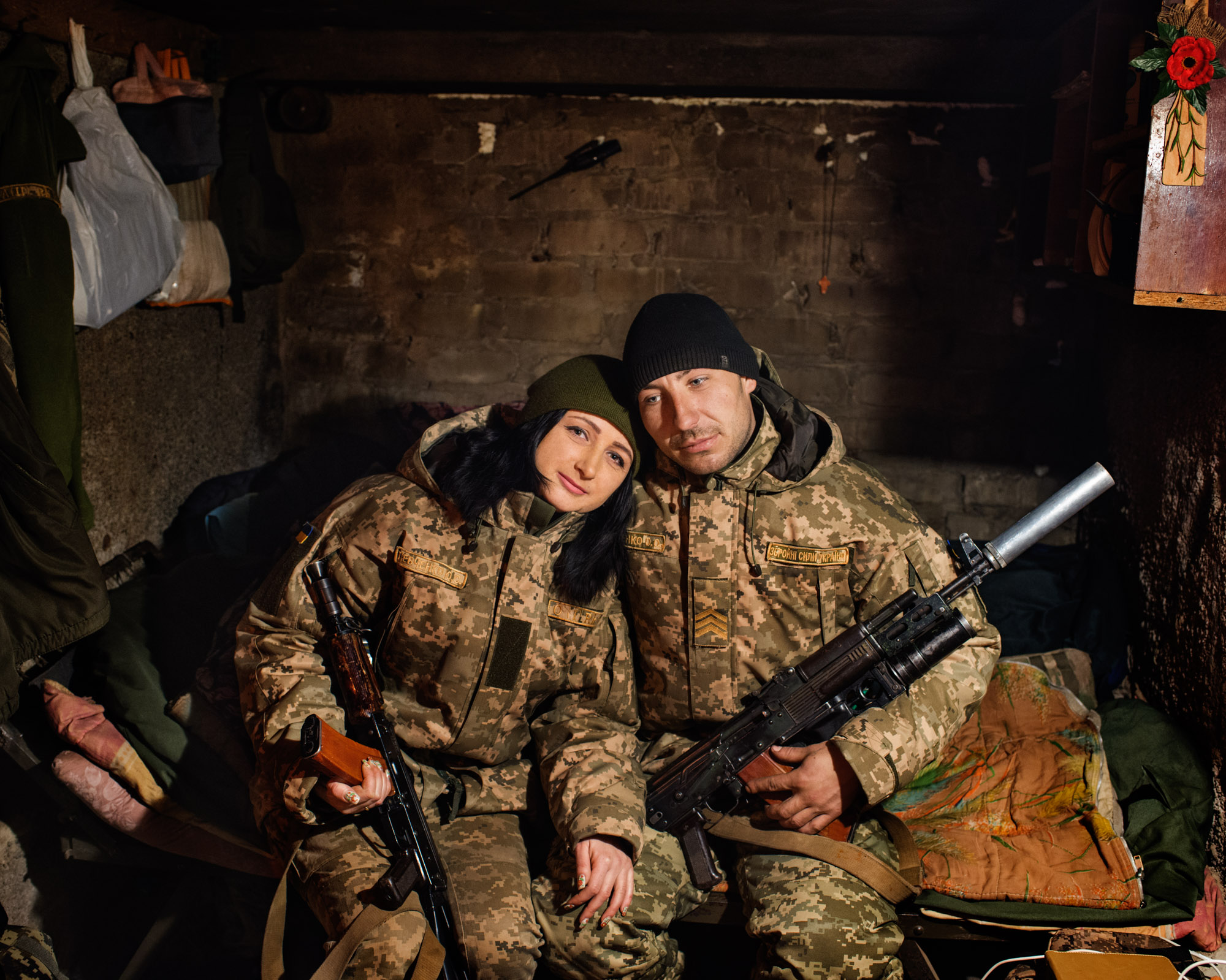
A married couple of Ukrainian soldiers, Yulia and Oleksiy, who were stationed between Popasna and Pershotravnev in February 2017
What should we do about photos, which are taken in the occupied territories, where there are no other sources of information and where photographers have to get Russian accreditation? I saw your photos from the separatist-controlled territories. Can you tell me about that experience?
Firstly, if you are a foreign photojournalist and you receive Russian accreditation and you are invited to go to the occupied territories, you should go, that’s for sure, but you should understand the context. And the context is that everything you see there is a part of Russian propaganda. You will see only what they want you to see. Being a journalist or photographer, your job is to explain to the Western audience how this system works. It can be your contribution to counter-propaganda.
You will see only what they want you to see. Being a journalist or photographer, your job is to explain to the Western audience how this system works.
I’ve been on both sides of the frontline in 2014-2016. I wanted to show how the societies of the so-called People’s Republics of Donetsk and Luhansk live and change. Back in the day, photographers’ work wasn’t strictly regulated and I was able to travel across the so-called republics. Being a part of the organized press tours for foreign media, I made a photo diary for a French-German channel, ARTE. I was documenting the tools of propaganda, the bandits that came to power, and all the terrors and violence which were happening in the occupied territories. The ARTE channel showed my diary for ten days in a row.
Since 2016, Russians have almost completely stopped giving accreditations to foreign journalists. In particular, it applied to journalists and photographers who have been to Ukraine before 2014. In other words, people who knew what was going on in Ukraine and what started the war were not allowed to cross the frontline. Access was given only to those journalists who haven’t been to Ukraine before 2014 or who worked for Russian propaganda. That was their way to manipulate information.
Foreign media often send their photojournalists to Ukraine instead of working with Ukrainian photographers. In your opinion, what are the pros and cons of an outside view at the war?
I think it is important to look at the war from the outside and tell the story not only from the viewpoint of a country that is directly involved in the war. This might be the main reason why foreign media often cooperate with foreign photographers. But I also think that currently the works of Ukrainian photographers, who document the war, are second to none.
The upside of working with foreign photographers is the bond that they have with their colleagues, foreign journalists. A photographer and a journalist work as a team, they speak one language, they know each other well, they might have worked together before. And their cooperation becomes more effective due to that. Another advantage is that foreign journalists come to Ukraine for an assignment. They have no other things to do, no private lives that distract them from their work. During the two-three weeks period of the assignment, a photographer is fully focused on the material that they are working on.
As for the disadvantages, sometimes the media send photographers who know nothing about Ukraine. When you go to document the war, it is crucially important to have general knowledge of the country’s culture, politics, and history. It applies not only to Ukraine but to any country.
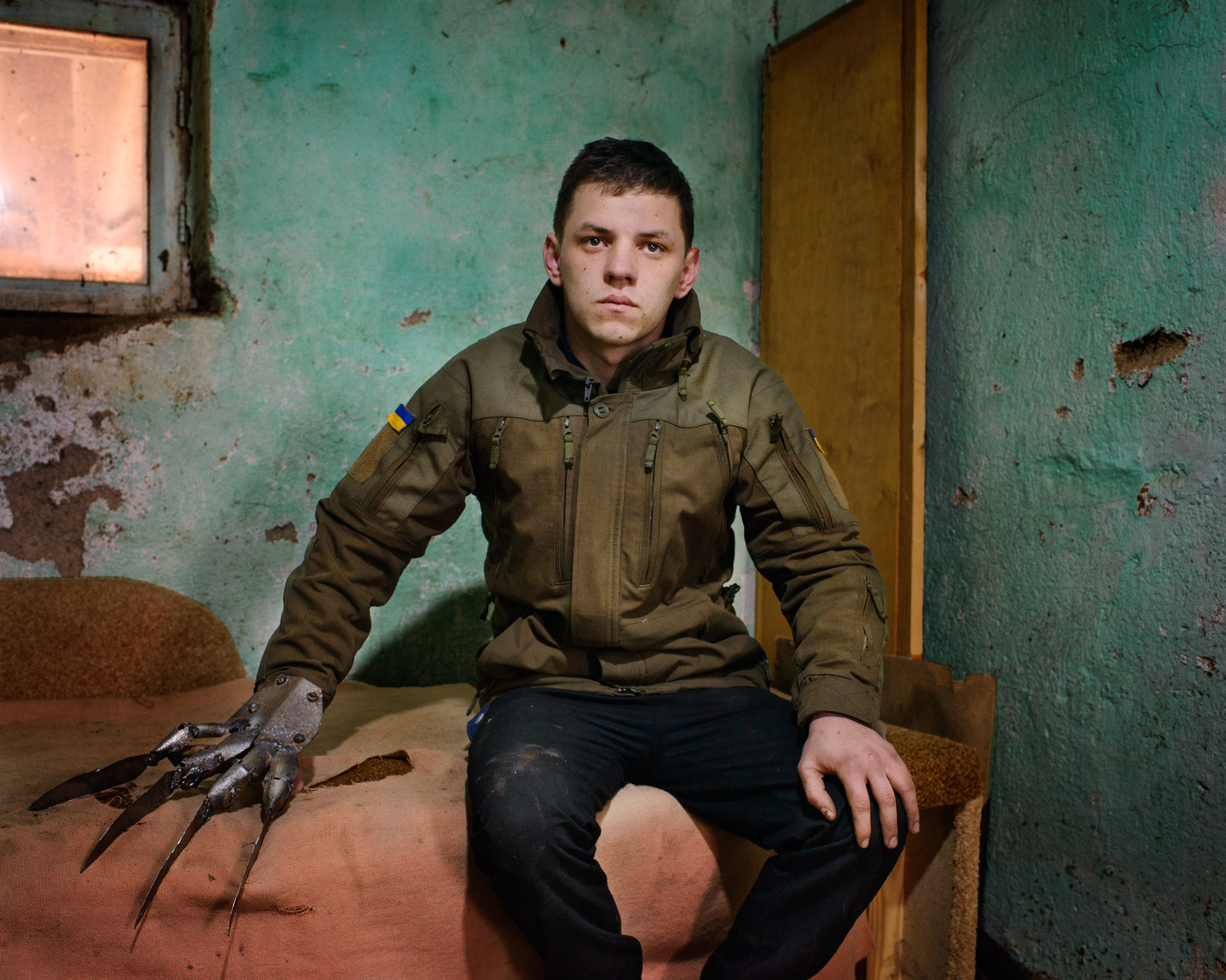
Gulyaipole, 2019. Oleksandr Yanushkevich, 24, spent five months at the frontline, cooking for the Ukrainian military. He began creating metal artifacts after he came back home
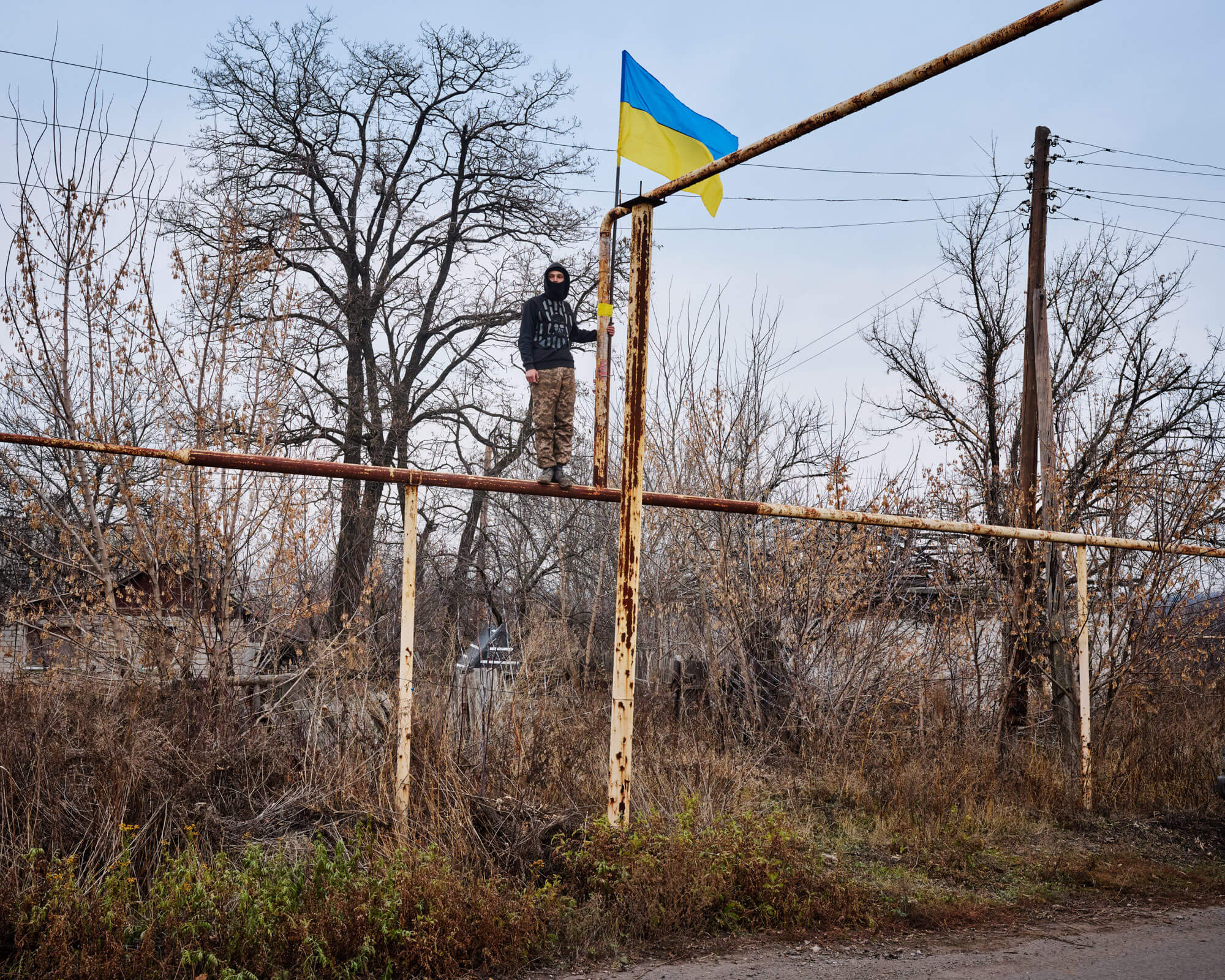
Zaitseve, 2021. A Ukrainian soldier raises the national flag in Donbas
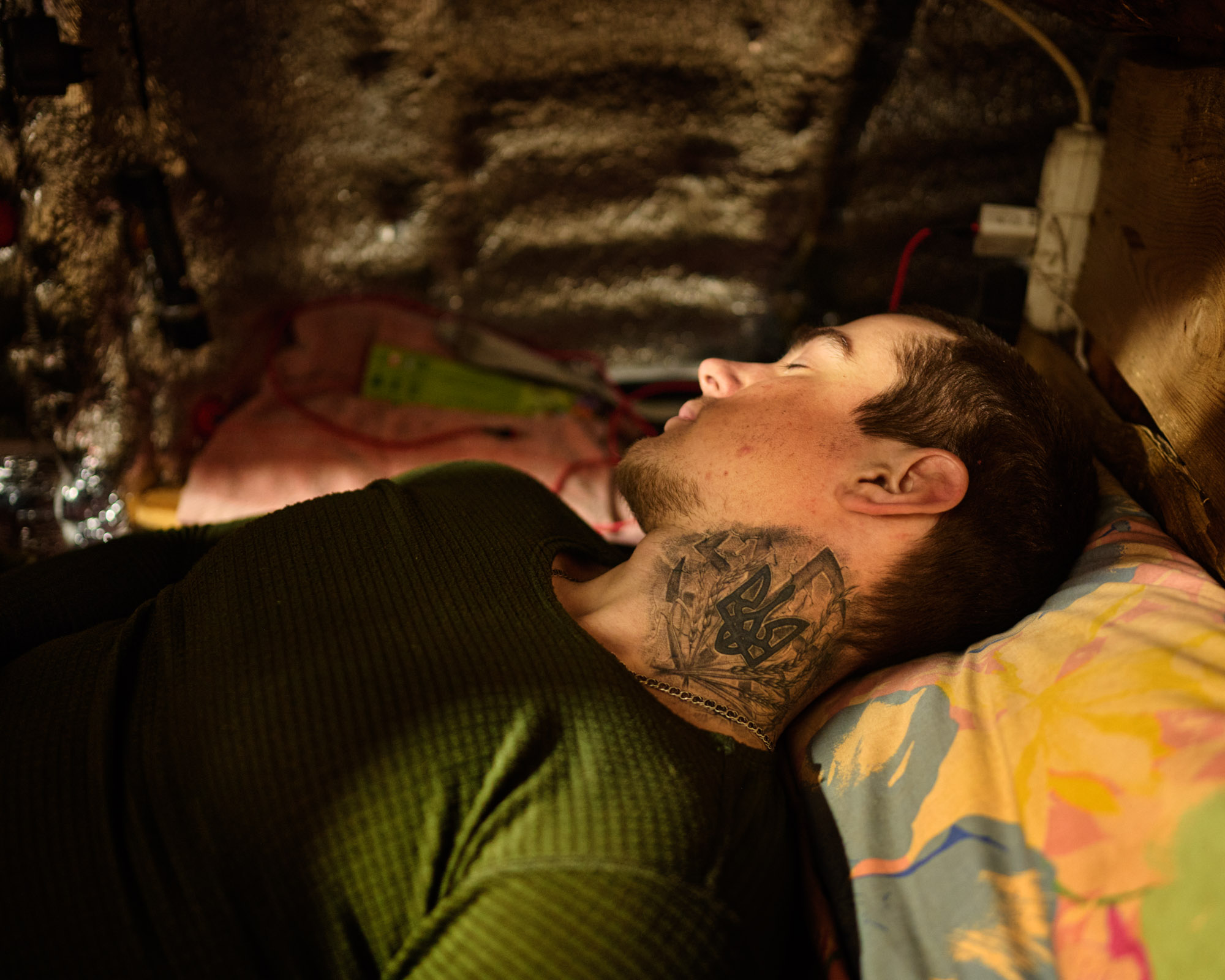
Avdiivka, January 2022
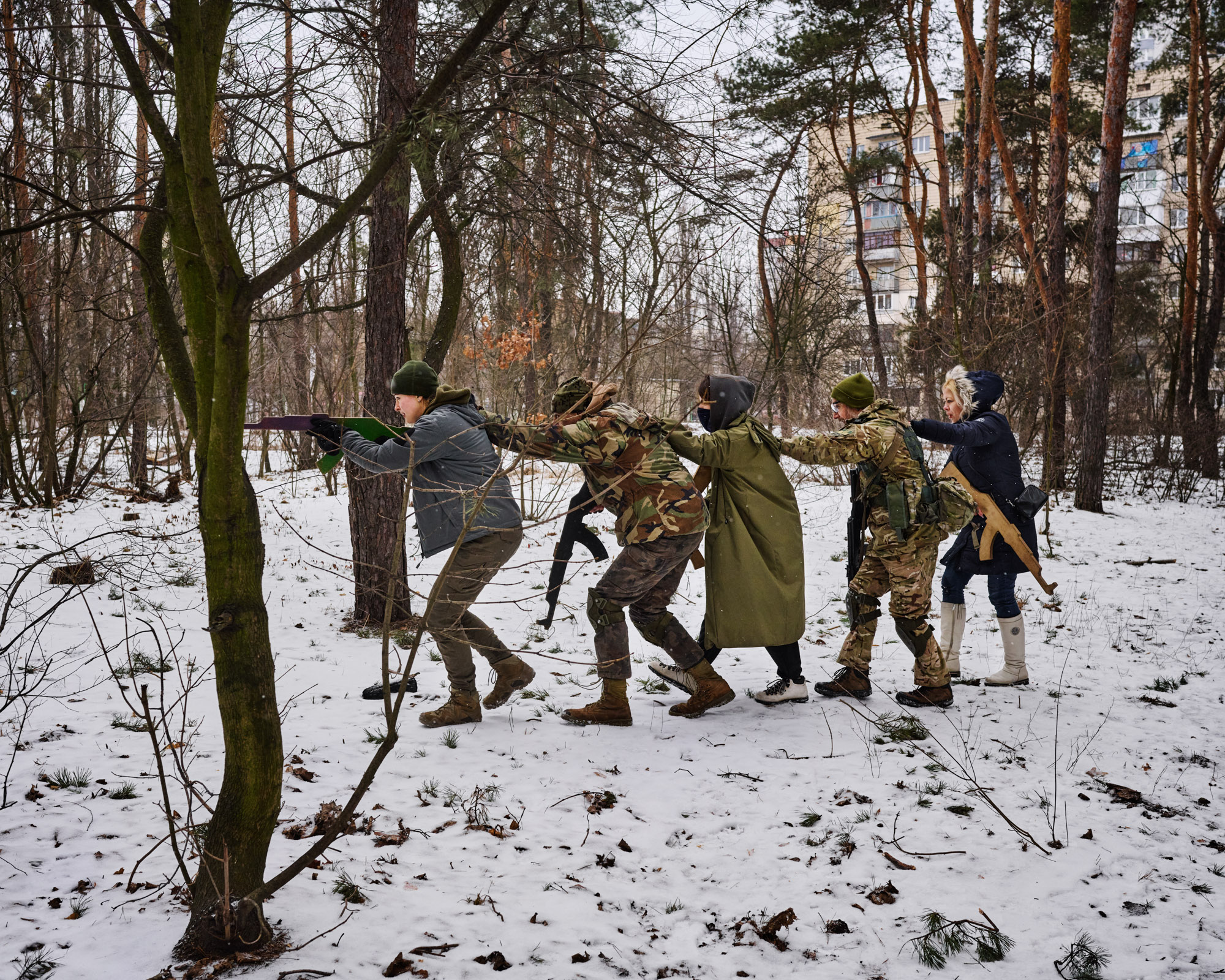
Kyiv, 2022. Civilian Ukrainians participate in training organized by the military in the Dniprovsky region
You definitely don’t have such a problem since you’ve been working in Ukraine for many years. In particular, you’ve been taking photos of Chornobyl. What’s the difference between documenting past tragedies and reporting the war that is happening here and now?
For me, these are inseparable things. This tragedy is a continuation of past tragedies. Knowing what Ukraine has been through helps me document this war. My experience of working in Chornobyl gives me the needed distance to comprehend what’s happening now. For instance, there is a small village in the Chornobyl zone called Zalissia. It was evacuated after the accident at the Chornobyl nuclear power plant. People were moved to a new village in the Kyiv region which was named New Zalissia — and it was occupied in March 2022. Knowing this story, we went there together with a Le Monde journalist to tell about people who suffered from a double tragedy.
Recently, I published my book, which is dedicated to my twenty years of work in Ukraine. Among other things, I wanted to highlight the reasons behind the Russian-Ukrainian war in this book. When people see my images, they often accuse me of photographing the youth only. And that is true. It hurts me to see that the young generation is always at the forefront of historical events. Young people took part in the liquidation of the Chornobyl nuclear plant consequences; in 1990 the young generation started the Revolution on granite; their children joined the Orange revolution in 2004; the Revolution of Dignity started with student protests. And now, once again, young people take up weapons and join the army to protect the independence of Ukraine. It breaks my heart to see the youth protecting their home and even more — protecting the whole Europe.
When people see my images, they often accuse me of photographing the youth only. And that is true. It hurts me to see that the young generation is always at the forefront of historical events.
What’s the role of a military photographer and how has it changed in the last ten or twenty years?
The role of a military photographer is a multi-level question. One should understand that we have lots of amateurish photographers now. The first photos from the scene are usually taken by people who have mobile phones and happen to be there. In most cases, professional photographers come afterward. It means that we now have more and more photographers — some of them are just witnesses of the events and some of them are victims themselves. It wasn’t like that twenty years ago. The number of professional photographers also goes up — at the beginning of the full-scale invasion, there were about 2 300 photographers working in Ukraine. So I keep asking myself: why am I going there too? That’s why I try to tell the story in a different way, to take photos that will stand out amidst the images we see when we scroll through our social media feeds.
There are many extra-class professional photographers in Ukraine. Take, for example, Yevhen Maloletka. He actually fits into the long-standing tradition of military photography, which lasts since the first image of the war was taken. In my opinion, he is the best Ukrainian military photographer now. Foreign photographers come after Ukrainian reporters have done their job and we have to think about new angles to present our stories.
The process of getting permission to work on the frontline has changed a lot, too. It’s very hard to get permission to access the first line now, and when it comes to photographing the military it’s almost impossible. We mostly work on the second and third front lines. We have no right to take photos of the servicemen’s faces. It wasn’t prohibited twenty years ago. Because unlike the times of film photography, now an image can travel around the world in an instant and threaten the safety of a serviceman whom it shows. So today we must take care of those people who happen to be in our images.
Unlike the times of film photography, now an image can travel around the world in an instant and threaten the safety of a serviceman whom it shows. So today we must take care of those people who happen to be in our images.
Finally, I’d like to ask you about the moods in France. Are people tired of the war?
I think the situation is quite optimistic. Ukraine remains in the French newspapers. Of course, it’s hard for me to talk on behalf of French society in general, but I can say that people still worry about the war in Ukraine and watch Russia with fear.

A monument to Shevchenko was damaged during the shelling of the village of Borodyanka in the Kyiv region. May 2022
New and best




